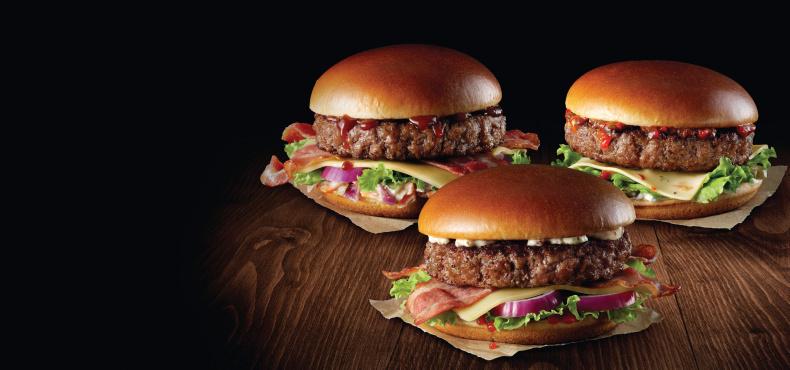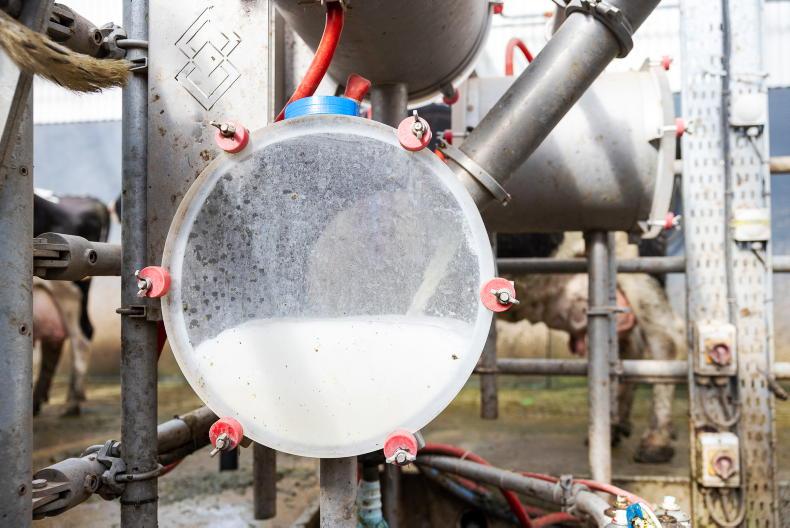Siobhan Talbot, Glanbia’s group managing director, has just finished a countrywide series of meetings with farmer shareholders to explain the reasons behind restructuring Glanbia’s Irish operations.
The proposal will see the plc sell 60% of its ownership in its consumer foods and agribusiness to the co-op and create a new joint venture called Glanbia Ireland.
The co-op, which has a €1.8bn shareholding in the plc, will sell 3% of its shares valued at around €112m to fund the deal. The co-op also wants to return €100m to farmer shareholders by selling down a further 2% of its plc shareholding.
While it appears straightforward, in her 25th year with the group, Talbot is more than familiar with the hurdles involved having witnessed the initial failed restructuring of the dairy processing business back in 2009. This restructuring eventually succeeded through the establishment of the joint venture, Glanbia Ingredients Ireland, in 2012.

Five years on, with the company now under her leadership, Talbot wants to make sure that this time round it goes much smoother. Leaving nothing to chance, she has been present at almost every farmer meeting to explain the deal.
Fundamentally, she believes this is a good deal for farmers, claiming that “farmers will have a majority ownership, through their co-op, of the business that is most aligned to that of their farm”.
She says this is important given the ambition of the Glanbia supply base, which has indicated its wish to expand a further 30% between now and 2020.
This will cement Glanbia Ireland as the largest dairy processor in the country, processing 2.4bn litres of milk expanding to over 3bn litres in three years’ time.
With almost four years under her belt as head of the Glanbia group, this looks set to be Talbot’s biggest challenge to date. If successful, it will endorse her leadership with farmer shareholders, firmly put her stamp on the business and lead to the development of the future strategy of the group.
That’s not to say she has been idle since taking over as group managing director in November 2013. At the time, Glanbia had a turnover of €3.5bn and had earnings (profits) of €245m. Its ingredients business was by far the largest part of the group, accounting for a third of the business (34%) and almost half (41%) of profits.

But over the last four years, through a combination of organic growth and a hefty acquisitions programme, Glanbia has seen €100m added to profits (up 43%) and its share price double. Increasingly, less of the profits have been coming directly from its milk pool.
Performance nutrition has been by far the biggest driver, accounting for 70% of the growth.
After first entering the segment almost 10 years ago, when it bought Optimum Nutrition, Glanbia has bolted on a stable of brands including BSN, Isopure, Nutramino, Thinkthin and most recently Amazing Grass and Body & Fit.
At a total cost of just over €1bn, these acquisitions have made Glanbia the world’s largest holder of performance nutrition brands.
It now commands 12% to 13% of the global branded sports nutrition market, which is estimated to be worth €11bn. This division now contributes €1bn in annual revenues, has margins in excess of 16% and accounts for almost half (46%) of the profits that Glanbia now makes.
Although it has been overshadowed by the performance nutrition division, Glanbia’s ingredients business has also been performing, albeit at a slower rate. While Glanbia has been acquiring performance nutrition businesses, it has been quietly investing significant capital in its ingredients business and is currently restructuring this division.
Primary processing through joint ventures
If you look at the evolution of the plc, a lot of primary dairy processing is now conducted through joint ventures such as Southwest Cheese in the US, and its planned cheese and whey joint venture in Michigan with three dairy co-ops.
The establishment of Glanbia Ireland sits within this strategy and provides further clarity to shareholders on the Glanbia model.
Processing around 4bn litres of milk in the US, Glanbia is the largest American-style cheddar cheese producer and accounts for almost 25% of US cheese output. And of course this provides access to whey, the by-product of cheese production, which offers Glanbia a key competitive advantage over its performance nutrition competitors.
A commodity, subject to the vagaries of global markets, it provides a hedge where Glanbia can sell whey ingredients direct to its performance nutrition business and capture two parts of the value along the supply chain – ingredients and brands.

Capturing this extra value along the supply chain has allowed Glanbia plc’s largest shareholder, Glanbia Co-op, to cushion its farmer members when dairy and grain commodity markets are low.
The growth in the plc’s profits and market capitalisation to €5bn today, has allowed the co-op to leverage a healthy dividend stream and a rising asset value to support its farmers in ways no other co-op can match.
From a combination of dividends and share spin-outs, the co-op has returned €780m to its 14,800 farmer members since 2012. In the last two years alone, Glanbia Co-op has distributed €115m in milk and grain price supports.
Talbot understands that the situation for Glanbia’s supply base is toughest when markets are poor and that, justifiably, co-ops need to support their members when market levels are below expectations.
She argues that the Glanbia model offers this support to farmers through the development of innovative products, such as its GAP and Milkflex schemes, along with the scale and efficiency at processing level through commercially run businesses.
One additional strength of the Glanbia model has been its financial ability to build the processing capacity necessary in response to its farmers doubling milk production from 1.6bn to 3bn litres by 2020.
In the lead-up to the lifting of dairy quotas, Glanbia Ingredients Ireland, its milk processing joint venture with the co-op, invested a total of €300m building the Belview facility along with readying its existing sites to process the extra milk.
But just two years post-quotas and with a surge of milk continuing to come from its supply base, GII has announced plans to further invest between €250m and €300m in additional capacity expansion.
Keeping the growth going
If the Glanbia Ireland deal goes ahead, it will achieve three things. Firstly, it provides farmers with the necessary capacity to process their milk into the future.
Secondly, it gives majority ownership to farmers of a business most aligned to theirs. And, finally, it provides clarity to the plc shareholders around the Glanbia business model.
However, the constant challenge for Talbot will be continuing the growth of Glanbia. Over the last seven years, the business has enjoyed consecutive double-digit annual growth. And, in 2017, it has set a target of 7% to 10% annual growth, which Talbot is confident that Glanbia can deliver.
She says it’s all about where you choose to play and then about how you win. Glanbia is playing into some fundamentally positive trends in nutrition such as health and wellbeing, active lifestyles and convenience, according to Talbot.

While Glanbia’s core capability is in dairy, it is building increasing capability in non-dairy. She says this was one of the reasons in buying the Amazing Grass business last year, which moves Glanbia into the plant protein space.
Glanbia also made its first moves into selling direct to consumers when it bought Body & Fit last year, an online retail business.
The acquisition of Body & Fit is a new direction for Glanbia as online retailing is the furthest downstream it’s moved from its core. It’s hard to imagine Glanbia, as a manufacturer of whey proteins, envisaged going so far down this route when it first set foot into the performance nutrition market almost a decade ago.
However, Talbot doesn’t believe the Body & Fit deal is the start of Glanbia moving further downstream.
She says it’s more about capturing a greater amount of the value chain and bringing more consumers into contact with Glanbia brands.
What’s clear is that the sports nutrition market is evolving. Originally protein supplements developed on the back streets of America with a cult-like following. As health and fitness become more important to regular consumers, performance nutrition products have become more mainstream. For Glanbia, while the original strength consumer of whey protein is still important, the company’s recent acquisitions reflect the growing prominence of the lifestyle consumer category.
Rooted in rural Ireland
So as farmers decide on the future shape of Glanbia, which if approved will see Glanbia plc moving further from the farmgate than ever before, Talbot doesn’t see Glanbia leaving Kilkenny, saying the company’s roots are firmly based in rural Ireland.
After her recent farmer meetings, she says she enjoys engaging with farmer shareholders who are very passionate, and rightly emotional about how this business is connecting with their business.
But aside from farmers being Glanbia’s largest shareholder, she also has to manage the expectations of an investor base spread across London, Frankfurt and New York who are about value creation. She concludes that the farmer DNA in the company in no way hostages its ambition, saying that farmers are as ambitious as anybody else.
The 2017Irish Farmers Journal/KPMG Agribusiness report entitled Agricultural Thinking: inside the minds of global agri leaders comes free with this week's Irish Farmers Journal.
Sustainability top of agenda at Agribusiness event
Key insights from Greencore's Coveney
Irish Farmers Journal/KPMG Agribusiness Report 2017
Siobhan Talbot, Glanbia’s group managing director, has just finished a countrywide series of meetings with farmer shareholders to explain the reasons behind restructuring Glanbia’s Irish operations.
The proposal will see the plc sell 60% of its ownership in its consumer foods and agribusiness to the co-op and create a new joint venture called Glanbia Ireland.
The co-op, which has a €1.8bn shareholding in the plc, will sell 3% of its shares valued at around €112m to fund the deal. The co-op also wants to return €100m to farmer shareholders by selling down a further 2% of its plc shareholding.
While it appears straightforward, in her 25th year with the group, Talbot is more than familiar with the hurdles involved having witnessed the initial failed restructuring of the dairy processing business back in 2009. This restructuring eventually succeeded through the establishment of the joint venture, Glanbia Ingredients Ireland, in 2012.

Five years on, with the company now under her leadership, Talbot wants to make sure that this time round it goes much smoother. Leaving nothing to chance, she has been present at almost every farmer meeting to explain the deal.
Fundamentally, she believes this is a good deal for farmers, claiming that “farmers will have a majority ownership, through their co-op, of the business that is most aligned to that of their farm”.
She says this is important given the ambition of the Glanbia supply base, which has indicated its wish to expand a further 30% between now and 2020.
This will cement Glanbia Ireland as the largest dairy processor in the country, processing 2.4bn litres of milk expanding to over 3bn litres in three years’ time.
With almost four years under her belt as head of the Glanbia group, this looks set to be Talbot’s biggest challenge to date. If successful, it will endorse her leadership with farmer shareholders, firmly put her stamp on the business and lead to the development of the future strategy of the group.
That’s not to say she has been idle since taking over as group managing director in November 2013. At the time, Glanbia had a turnover of €3.5bn and had earnings (profits) of €245m. Its ingredients business was by far the largest part of the group, accounting for a third of the business (34%) and almost half (41%) of profits.

But over the last four years, through a combination of organic growth and a hefty acquisitions programme, Glanbia has seen €100m added to profits (up 43%) and its share price double. Increasingly, less of the profits have been coming directly from its milk pool.
Performance nutrition has been by far the biggest driver, accounting for 70% of the growth.
After first entering the segment almost 10 years ago, when it bought Optimum Nutrition, Glanbia has bolted on a stable of brands including BSN, Isopure, Nutramino, Thinkthin and most recently Amazing Grass and Body & Fit.
At a total cost of just over €1bn, these acquisitions have made Glanbia the world’s largest holder of performance nutrition brands.
It now commands 12% to 13% of the global branded sports nutrition market, which is estimated to be worth €11bn. This division now contributes €1bn in annual revenues, has margins in excess of 16% and accounts for almost half (46%) of the profits that Glanbia now makes.
Although it has been overshadowed by the performance nutrition division, Glanbia’s ingredients business has also been performing, albeit at a slower rate. While Glanbia has been acquiring performance nutrition businesses, it has been quietly investing significant capital in its ingredients business and is currently restructuring this division.
Primary processing through joint ventures
If you look at the evolution of the plc, a lot of primary dairy processing is now conducted through joint ventures such as Southwest Cheese in the US, and its planned cheese and whey joint venture in Michigan with three dairy co-ops.
The establishment of Glanbia Ireland sits within this strategy and provides further clarity to shareholders on the Glanbia model.
Processing around 4bn litres of milk in the US, Glanbia is the largest American-style cheddar cheese producer and accounts for almost 25% of US cheese output. And of course this provides access to whey, the by-product of cheese production, which offers Glanbia a key competitive advantage over its performance nutrition competitors.
A commodity, subject to the vagaries of global markets, it provides a hedge where Glanbia can sell whey ingredients direct to its performance nutrition business and capture two parts of the value along the supply chain – ingredients and brands.

Capturing this extra value along the supply chain has allowed Glanbia plc’s largest shareholder, Glanbia Co-op, to cushion its farmer members when dairy and grain commodity markets are low.
The growth in the plc’s profits and market capitalisation to €5bn today, has allowed the co-op to leverage a healthy dividend stream and a rising asset value to support its farmers in ways no other co-op can match.
From a combination of dividends and share spin-outs, the co-op has returned €780m to its 14,800 farmer members since 2012. In the last two years alone, Glanbia Co-op has distributed €115m in milk and grain price supports.
Talbot understands that the situation for Glanbia’s supply base is toughest when markets are poor and that, justifiably, co-ops need to support their members when market levels are below expectations.
She argues that the Glanbia model offers this support to farmers through the development of innovative products, such as its GAP and Milkflex schemes, along with the scale and efficiency at processing level through commercially run businesses.
One additional strength of the Glanbia model has been its financial ability to build the processing capacity necessary in response to its farmers doubling milk production from 1.6bn to 3bn litres by 2020.
In the lead-up to the lifting of dairy quotas, Glanbia Ingredients Ireland, its milk processing joint venture with the co-op, invested a total of €300m building the Belview facility along with readying its existing sites to process the extra milk.
But just two years post-quotas and with a surge of milk continuing to come from its supply base, GII has announced plans to further invest between €250m and €300m in additional capacity expansion.
Keeping the growth going
If the Glanbia Ireland deal goes ahead, it will achieve three things. Firstly, it provides farmers with the necessary capacity to process their milk into the future.
Secondly, it gives majority ownership to farmers of a business most aligned to theirs. And, finally, it provides clarity to the plc shareholders around the Glanbia business model.
However, the constant challenge for Talbot will be continuing the growth of Glanbia. Over the last seven years, the business has enjoyed consecutive double-digit annual growth. And, in 2017, it has set a target of 7% to 10% annual growth, which Talbot is confident that Glanbia can deliver.
She says it’s all about where you choose to play and then about how you win. Glanbia is playing into some fundamentally positive trends in nutrition such as health and wellbeing, active lifestyles and convenience, according to Talbot.

While Glanbia’s core capability is in dairy, it is building increasing capability in non-dairy. She says this was one of the reasons in buying the Amazing Grass business last year, which moves Glanbia into the plant protein space.
Glanbia also made its first moves into selling direct to consumers when it bought Body & Fit last year, an online retail business.
The acquisition of Body & Fit is a new direction for Glanbia as online retailing is the furthest downstream it’s moved from its core. It’s hard to imagine Glanbia, as a manufacturer of whey proteins, envisaged going so far down this route when it first set foot into the performance nutrition market almost a decade ago.
However, Talbot doesn’t believe the Body & Fit deal is the start of Glanbia moving further downstream.
She says it’s more about capturing a greater amount of the value chain and bringing more consumers into contact with Glanbia brands.
What’s clear is that the sports nutrition market is evolving. Originally protein supplements developed on the back streets of America with a cult-like following. As health and fitness become more important to regular consumers, performance nutrition products have become more mainstream. For Glanbia, while the original strength consumer of whey protein is still important, the company’s recent acquisitions reflect the growing prominence of the lifestyle consumer category.
Rooted in rural Ireland
So as farmers decide on the future shape of Glanbia, which if approved will see Glanbia plc moving further from the farmgate than ever before, Talbot doesn’t see Glanbia leaving Kilkenny, saying the company’s roots are firmly based in rural Ireland.
After her recent farmer meetings, she says she enjoys engaging with farmer shareholders who are very passionate, and rightly emotional about how this business is connecting with their business.
But aside from farmers being Glanbia’s largest shareholder, she also has to manage the expectations of an investor base spread across London, Frankfurt and New York who are about value creation. She concludes that the farmer DNA in the company in no way hostages its ambition, saying that farmers are as ambitious as anybody else.
The 2017Irish Farmers Journal/KPMG Agribusiness report entitled Agricultural Thinking: inside the minds of global agri leaders comes free with this week's Irish Farmers Journal.
Sustainability top of agenda at Agribusiness event
Key insights from Greencore's Coveney
Irish Farmers Journal/KPMG Agribusiness Report 2017



















SHARING OPTIONS